Fifth National Plan and Suicide Prevention in Australia: A Report
VerifiedAdded on 2022/09/14
|12
|3521
|10
Report
AI Summary
This report provides an in-depth analysis of Australia's Fifth National Plan for Suicide Prevention, examining the plan's objectives and strategies for addressing the country's high suicide rates. It explores the various factors contributing to mental illness and suicidal tendencies, including discrimination against LGBTI individuals, eating disorders, trauma, depression, and the pressures faced by Aboriginal communities, adolescents, and senior citizens. The report highlights the crucial role of nurses in providing support and interventions, emphasizing the need for training in mental health and suicide prevention. It also discusses government initiatives, such as the establishment of committees and action plans, aimed at reducing suicide rates and improving mental health services. The report underscores the importance of early intervention, stigma reduction, and comprehensive care to address the complex challenges of suicide prevention in Australia.
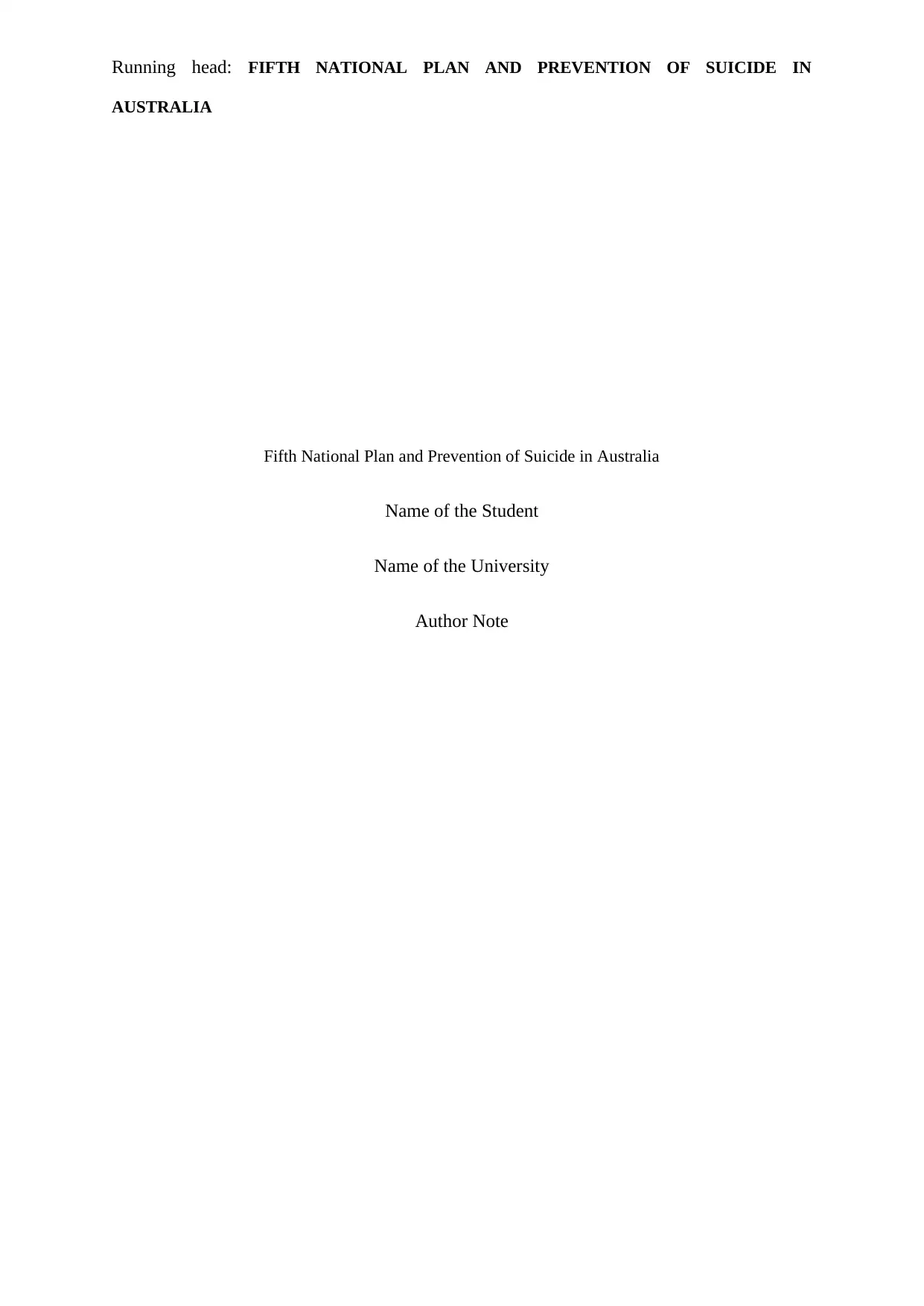
Running head: FIFTH NATIONAL PLAN AND PREVENTION OF SUICIDE IN
AUSTRALIA
Fifth National Plan and Prevention of Suicide in Australia
Name of the Student
Name of the University
Author Note
AUSTRALIA
Fifth National Plan and Prevention of Suicide in Australia
Name of the Student
Name of the University
Author Note
Paraphrase This Document
Need a fresh take? Get an instant paraphrase of this document with our AI Paraphraser
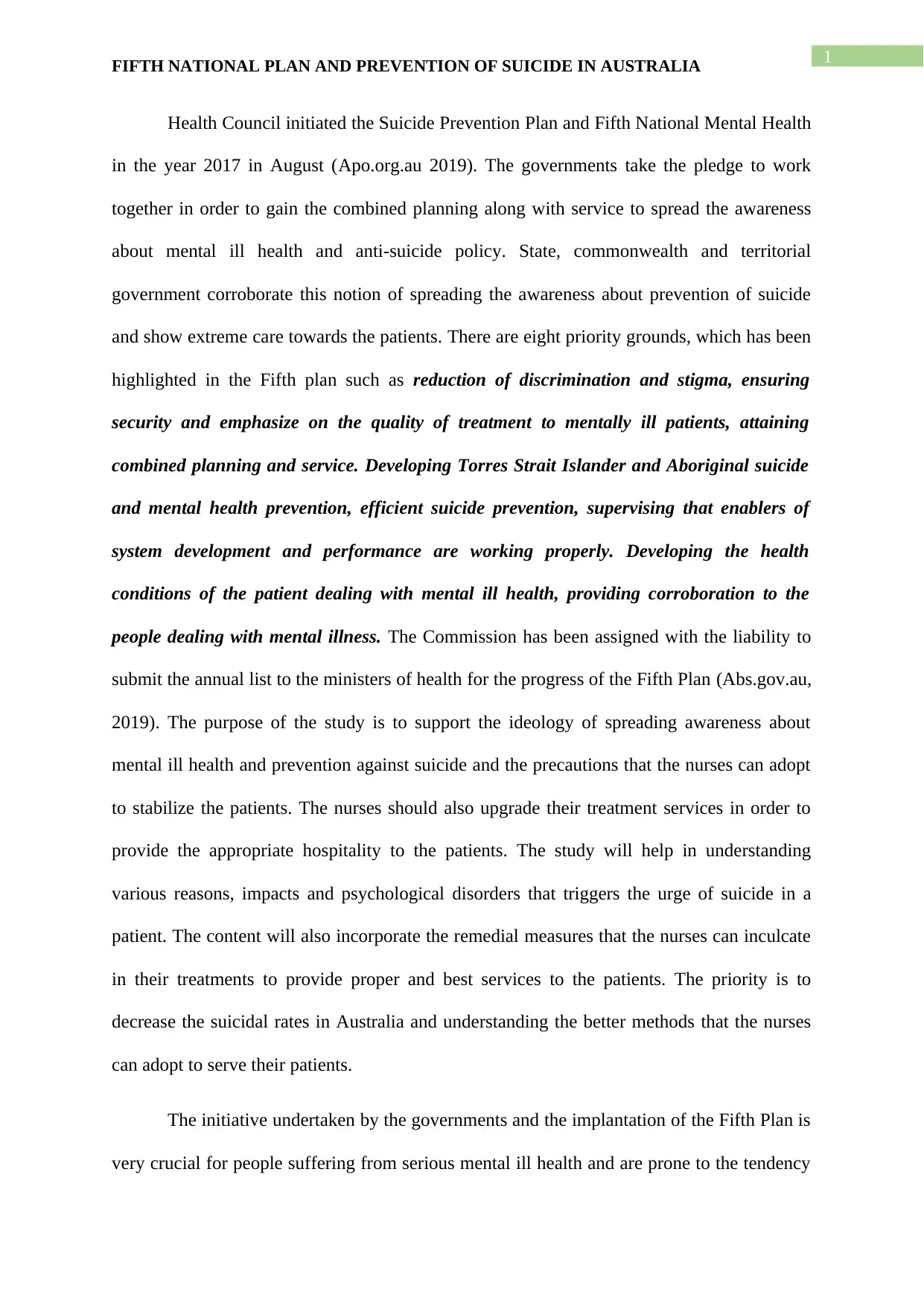
1FIFTH NATIONAL PLAN AND PREVENTION OF SUICIDE IN AUSTRALIA
Health Council initiated the Suicide Prevention Plan and Fifth National Mental Health
in the year 2017 in August (Apo.org.au 2019). The governments take the pledge to work
together in order to gain the combined planning along with service to spread the awareness
about mental ill health and anti-suicide policy. State, commonwealth and territorial
government corroborate this notion of spreading the awareness about prevention of suicide
and show extreme care towards the patients. There are eight priority grounds, which has been
highlighted in the Fifth plan such as reduction of discrimination and stigma, ensuring
security and emphasize on the quality of treatment to mentally ill patients, attaining
combined planning and service. Developing Torres Strait Islander and Aboriginal suicide
and mental health prevention, efficient suicide prevention, supervising that enablers of
system development and performance are working properly. Developing the health
conditions of the patient dealing with mental ill health, providing corroboration to the
people dealing with mental illness. The Commission has been assigned with the liability to
submit the annual list to the ministers of health for the progress of the Fifth Plan (Abs.gov.au,
2019). The purpose of the study is to support the ideology of spreading awareness about
mental ill health and prevention against suicide and the precautions that the nurses can adopt
to stabilize the patients. The nurses should also upgrade their treatment services in order to
provide the appropriate hospitality to the patients. The study will help in understanding
various reasons, impacts and psychological disorders that triggers the urge of suicide in a
patient. The content will also incorporate the remedial measures that the nurses can inculcate
in their treatments to provide proper and best services to the patients. The priority is to
decrease the suicidal rates in Australia and understanding the better methods that the nurses
can adopt to serve their patients.
The initiative undertaken by the governments and the implantation of the Fifth Plan is
very crucial for people suffering from serious mental ill health and are prone to the tendency
Health Council initiated the Suicide Prevention Plan and Fifth National Mental Health
in the year 2017 in August (Apo.org.au 2019). The governments take the pledge to work
together in order to gain the combined planning along with service to spread the awareness
about mental ill health and anti-suicide policy. State, commonwealth and territorial
government corroborate this notion of spreading the awareness about prevention of suicide
and show extreme care towards the patients. There are eight priority grounds, which has been
highlighted in the Fifth plan such as reduction of discrimination and stigma, ensuring
security and emphasize on the quality of treatment to mentally ill patients, attaining
combined planning and service. Developing Torres Strait Islander and Aboriginal suicide
and mental health prevention, efficient suicide prevention, supervising that enablers of
system development and performance are working properly. Developing the health
conditions of the patient dealing with mental ill health, providing corroboration to the
people dealing with mental illness. The Commission has been assigned with the liability to
submit the annual list to the ministers of health for the progress of the Fifth Plan (Abs.gov.au,
2019). The purpose of the study is to support the ideology of spreading awareness about
mental ill health and prevention against suicide and the precautions that the nurses can adopt
to stabilize the patients. The nurses should also upgrade their treatment services in order to
provide the appropriate hospitality to the patients. The study will help in understanding
various reasons, impacts and psychological disorders that triggers the urge of suicide in a
patient. The content will also incorporate the remedial measures that the nurses can inculcate
in their treatments to provide proper and best services to the patients. The priority is to
decrease the suicidal rates in Australia and understanding the better methods that the nurses
can adopt to serve their patients.
The initiative undertaken by the governments and the implantation of the Fifth Plan is
very crucial for people suffering from serious mental ill health and are prone to the tendency
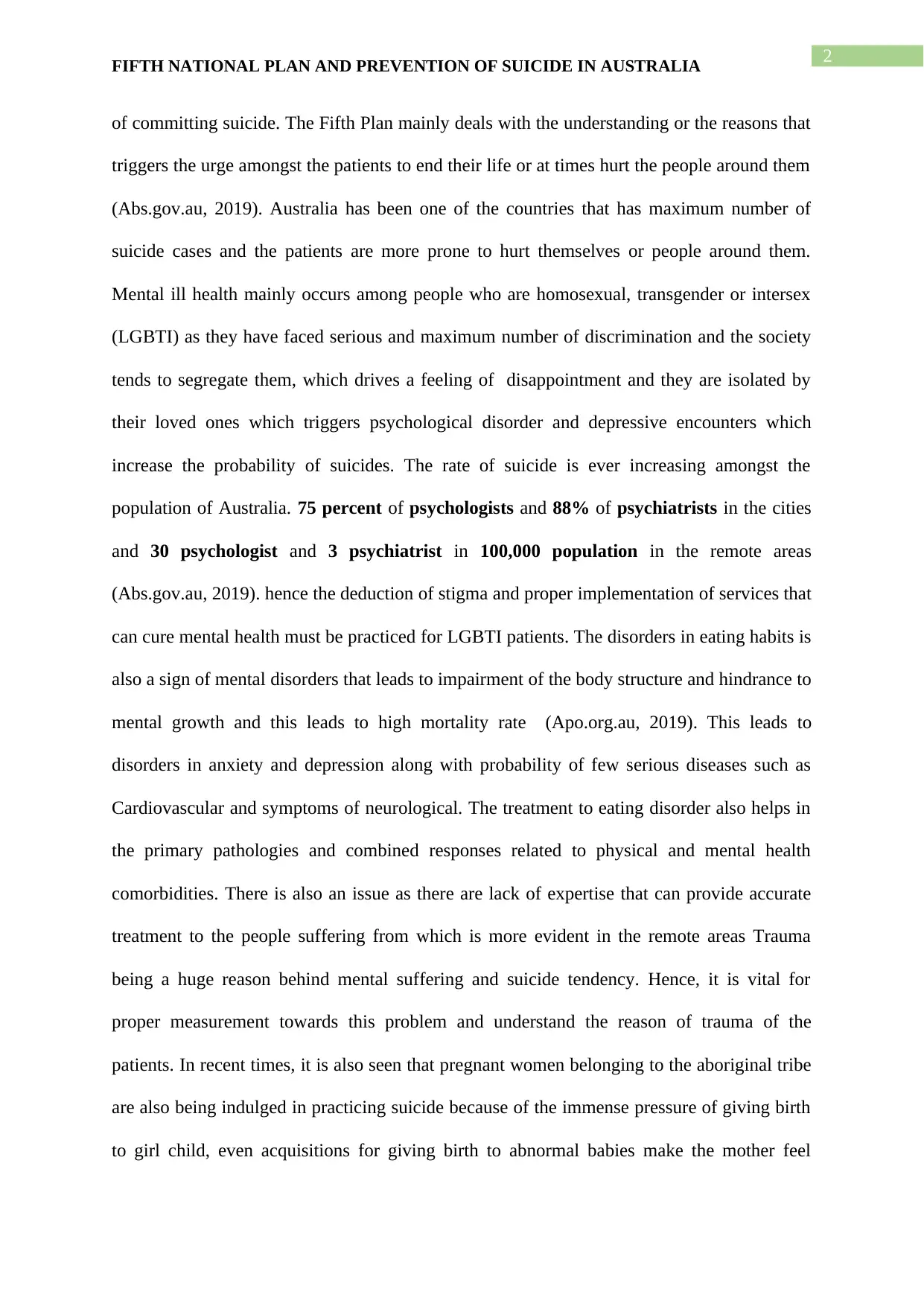
2FIFTH NATIONAL PLAN AND PREVENTION OF SUICIDE IN AUSTRALIA
of committing suicide. The Fifth Plan mainly deals with the understanding or the reasons that
triggers the urge amongst the patients to end their life or at times hurt the people around them
(Abs.gov.au, 2019). Australia has been one of the countries that has maximum number of
suicide cases and the patients are more prone to hurt themselves or people around them.
Mental ill health mainly occurs among people who are homosexual, transgender or intersex
(LGBTI) as they have faced serious and maximum number of discrimination and the society
tends to segregate them, which drives a feeling of disappointment and they are isolated by
their loved ones which triggers psychological disorder and depressive encounters which
increase the probability of suicides. The rate of suicide is ever increasing amongst the
population of Australia. 75 percent of psychologists and 88% of psychiatrists in the cities
and 30 psychologist and 3 psychiatrist in 100,000 population in the remote areas
(Abs.gov.au, 2019). hence the deduction of stigma and proper implementation of services that
can cure mental health must be practiced for LGBTI patients. The disorders in eating habits is
also a sign of mental disorders that leads to impairment of the body structure and hindrance to
mental growth and this leads to high mortality rate (Apo.org.au, 2019). This leads to
disorders in anxiety and depression along with probability of few serious diseases such as
Cardiovascular and symptoms of neurological. The treatment to eating disorder also helps in
the primary pathologies and combined responses related to physical and mental health
comorbidities. There is also an issue as there are lack of expertise that can provide accurate
treatment to the people suffering from which is more evident in the remote areas Trauma
being a huge reason behind mental suffering and suicide tendency. Hence, it is vital for
proper measurement towards this problem and understand the reason of trauma of the
patients. In recent times, it is also seen that pregnant women belonging to the aboriginal tribe
are also being indulged in practicing suicide because of the immense pressure of giving birth
to girl child, even acquisitions for giving birth to abnormal babies make the mother feel
of committing suicide. The Fifth Plan mainly deals with the understanding or the reasons that
triggers the urge amongst the patients to end their life or at times hurt the people around them
(Abs.gov.au, 2019). Australia has been one of the countries that has maximum number of
suicide cases and the patients are more prone to hurt themselves or people around them.
Mental ill health mainly occurs among people who are homosexual, transgender or intersex
(LGBTI) as they have faced serious and maximum number of discrimination and the society
tends to segregate them, which drives a feeling of disappointment and they are isolated by
their loved ones which triggers psychological disorder and depressive encounters which
increase the probability of suicides. The rate of suicide is ever increasing amongst the
population of Australia. 75 percent of psychologists and 88% of psychiatrists in the cities
and 30 psychologist and 3 psychiatrist in 100,000 population in the remote areas
(Abs.gov.au, 2019). hence the deduction of stigma and proper implementation of services that
can cure mental health must be practiced for LGBTI patients. The disorders in eating habits is
also a sign of mental disorders that leads to impairment of the body structure and hindrance to
mental growth and this leads to high mortality rate (Apo.org.au, 2019). This leads to
disorders in anxiety and depression along with probability of few serious diseases such as
Cardiovascular and symptoms of neurological. The treatment to eating disorder also helps in
the primary pathologies and combined responses related to physical and mental health
comorbidities. There is also an issue as there are lack of expertise that can provide accurate
treatment to the people suffering from which is more evident in the remote areas Trauma
being a huge reason behind mental suffering and suicide tendency. Hence, it is vital for
proper measurement towards this problem and understand the reason of trauma of the
patients. In recent times, it is also seen that pregnant women belonging to the aboriginal tribe
are also being indulged in practicing suicide because of the immense pressure of giving birth
to girl child, even acquisitions for giving birth to abnormal babies make the mother feel
⊘ This is a preview!⊘
Do you want full access?
Subscribe today to unlock all pages.

Trusted by 1+ million students worldwide
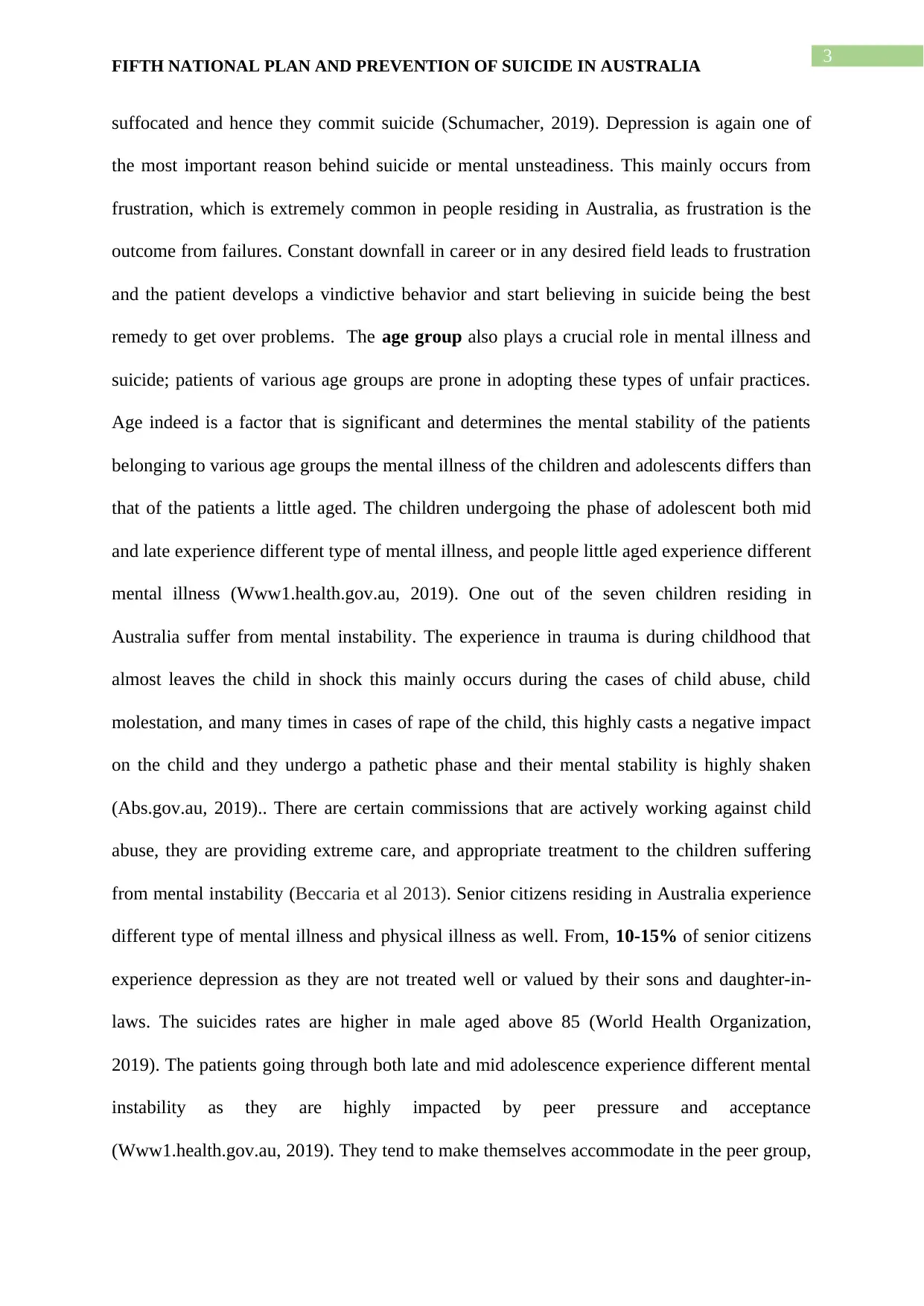
3FIFTH NATIONAL PLAN AND PREVENTION OF SUICIDE IN AUSTRALIA
suffocated and hence they commit suicide (Schumacher, 2019). Depression is again one of
the most important reason behind suicide or mental unsteadiness. This mainly occurs from
frustration, which is extremely common in people residing in Australia, as frustration is the
outcome from failures. Constant downfall in career or in any desired field leads to frustration
and the patient develops a vindictive behavior and start believing in suicide being the best
remedy to get over problems. The age group also plays a crucial role in mental illness and
suicide; patients of various age groups are prone in adopting these types of unfair practices.
Age indeed is a factor that is significant and determines the mental stability of the patients
belonging to various age groups the mental illness of the children and adolescents differs than
that of the patients a little aged. The children undergoing the phase of adolescent both mid
and late experience different type of mental illness, and people little aged experience different
mental illness (Www1.health.gov.au, 2019). One out of the seven children residing in
Australia suffer from mental instability. The experience in trauma is during childhood that
almost leaves the child in shock this mainly occurs during the cases of child abuse, child
molestation, and many times in cases of rape of the child, this highly casts a negative impact
on the child and they undergo a pathetic phase and their mental stability is highly shaken
(Abs.gov.au, 2019).. There are certain commissions that are actively working against child
abuse, they are providing extreme care, and appropriate treatment to the children suffering
from mental instability (Beccaria et al 2013). Senior citizens residing in Australia experience
different type of mental illness and physical illness as well. From, 10-15% of senior citizens
experience depression as they are not treated well or valued by their sons and daughter-in-
laws. The suicides rates are higher in male aged above 85 (World Health Organization,
2019). The patients going through both late and mid adolescence experience different mental
instability as they are highly impacted by peer pressure and acceptance
(Www1.health.gov.au, 2019). They tend to make themselves accommodate in the peer group,
suffocated and hence they commit suicide (Schumacher, 2019). Depression is again one of
the most important reason behind suicide or mental unsteadiness. This mainly occurs from
frustration, which is extremely common in people residing in Australia, as frustration is the
outcome from failures. Constant downfall in career or in any desired field leads to frustration
and the patient develops a vindictive behavior and start believing in suicide being the best
remedy to get over problems. The age group also plays a crucial role in mental illness and
suicide; patients of various age groups are prone in adopting these types of unfair practices.
Age indeed is a factor that is significant and determines the mental stability of the patients
belonging to various age groups the mental illness of the children and adolescents differs than
that of the patients a little aged. The children undergoing the phase of adolescent both mid
and late experience different type of mental illness, and people little aged experience different
mental illness (Www1.health.gov.au, 2019). One out of the seven children residing in
Australia suffer from mental instability. The experience in trauma is during childhood that
almost leaves the child in shock this mainly occurs during the cases of child abuse, child
molestation, and many times in cases of rape of the child, this highly casts a negative impact
on the child and they undergo a pathetic phase and their mental stability is highly shaken
(Abs.gov.au, 2019).. There are certain commissions that are actively working against child
abuse, they are providing extreme care, and appropriate treatment to the children suffering
from mental instability (Beccaria et al 2013). Senior citizens residing in Australia experience
different type of mental illness and physical illness as well. From, 10-15% of senior citizens
experience depression as they are not treated well or valued by their sons and daughter-in-
laws. The suicides rates are higher in male aged above 85 (World Health Organization,
2019). The patients going through both late and mid adolescence experience different mental
instability as they are highly impacted by peer pressure and acceptance
(Www1.health.gov.au, 2019). They tend to make themselves accommodate in the peer group,
Paraphrase This Document
Need a fresh take? Get an instant paraphrase of this document with our AI Paraphraser
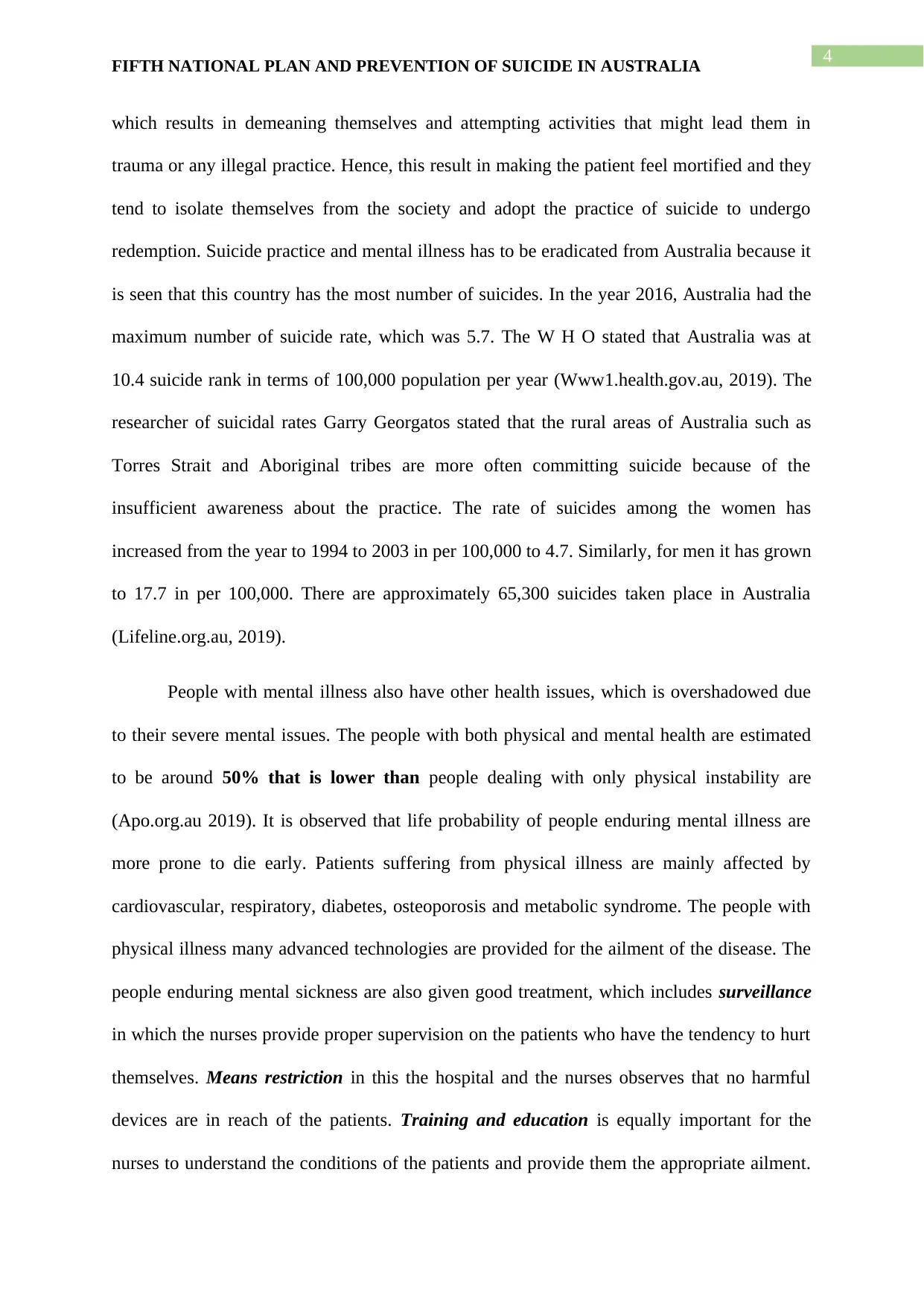
4FIFTH NATIONAL PLAN AND PREVENTION OF SUICIDE IN AUSTRALIA
which results in demeaning themselves and attempting activities that might lead them in
trauma or any illegal practice. Hence, this result in making the patient feel mortified and they
tend to isolate themselves from the society and adopt the practice of suicide to undergo
redemption. Suicide practice and mental illness has to be eradicated from Australia because it
is seen that this country has the most number of suicides. In the year 2016, Australia had the
maximum number of suicide rate, which was 5.7. The W H O stated that Australia was at
10.4 suicide rank in terms of 100,000 population per year (Www1.health.gov.au, 2019). The
researcher of suicidal rates Garry Georgatos stated that the rural areas of Australia such as
Torres Strait and Aboriginal tribes are more often committing suicide because of the
insufficient awareness about the practice. The rate of suicides among the women has
increased from the year to 1994 to 2003 in per 100,000 to 4.7. Similarly, for men it has grown
to 17.7 in per 100,000. There are approximately 65,300 suicides taken place in Australia
(Lifeline.org.au, 2019).
People with mental illness also have other health issues, which is overshadowed due
to their severe mental issues. The people with both physical and mental health are estimated
to be around 50% that is lower than people dealing with only physical instability are
(Apo.org.au 2019). It is observed that life probability of people enduring mental illness are
more prone to die early. Patients suffering from physical illness are mainly affected by
cardiovascular, respiratory, diabetes, osteoporosis and metabolic syndrome. The people with
physical illness many advanced technologies are provided for the ailment of the disease. The
people enduring mental sickness are also given good treatment, which includes surveillance
in which the nurses provide proper supervision on the patients who have the tendency to hurt
themselves. Means restriction in this the hospital and the nurses observes that no harmful
devices are in reach of the patients. Training and education is equally important for the
nurses to understand the conditions of the patients and provide them the appropriate ailment.
which results in demeaning themselves and attempting activities that might lead them in
trauma or any illegal practice. Hence, this result in making the patient feel mortified and they
tend to isolate themselves from the society and adopt the practice of suicide to undergo
redemption. Suicide practice and mental illness has to be eradicated from Australia because it
is seen that this country has the most number of suicides. In the year 2016, Australia had the
maximum number of suicide rate, which was 5.7. The W H O stated that Australia was at
10.4 suicide rank in terms of 100,000 population per year (Www1.health.gov.au, 2019). The
researcher of suicidal rates Garry Georgatos stated that the rural areas of Australia such as
Torres Strait and Aboriginal tribes are more often committing suicide because of the
insufficient awareness about the practice. The rate of suicides among the women has
increased from the year to 1994 to 2003 in per 100,000 to 4.7. Similarly, for men it has grown
to 17.7 in per 100,000. There are approximately 65,300 suicides taken place in Australia
(Lifeline.org.au, 2019).
People with mental illness also have other health issues, which is overshadowed due
to their severe mental issues. The people with both physical and mental health are estimated
to be around 50% that is lower than people dealing with only physical instability are
(Apo.org.au 2019). It is observed that life probability of people enduring mental illness are
more prone to die early. Patients suffering from physical illness are mainly affected by
cardiovascular, respiratory, diabetes, osteoporosis and metabolic syndrome. The people with
physical illness many advanced technologies are provided for the ailment of the disease. The
people enduring mental sickness are also given good treatment, which includes surveillance
in which the nurses provide proper supervision on the patients who have the tendency to hurt
themselves. Means restriction in this the hospital and the nurses observes that no harmful
devices are in reach of the patients. Training and education is equally important for the
nurses to understand the conditions of the patients and provide them the appropriate ailment.
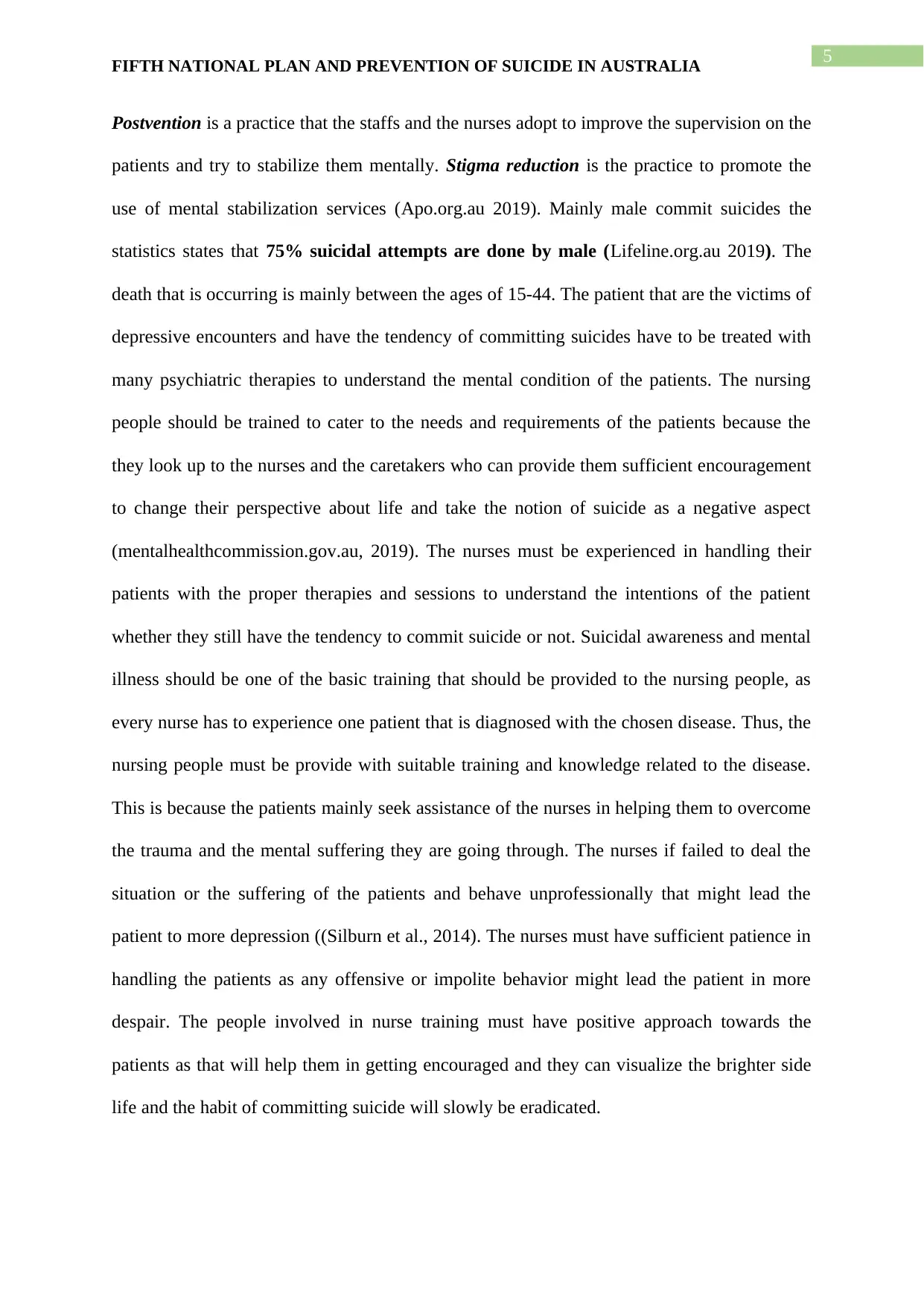
5FIFTH NATIONAL PLAN AND PREVENTION OF SUICIDE IN AUSTRALIA
Postvention is a practice that the staffs and the nurses adopt to improve the supervision on the
patients and try to stabilize them mentally. Stigma reduction is the practice to promote the
use of mental stabilization services (Apo.org.au 2019). Mainly male commit suicides the
statistics states that 75% suicidal attempts are done by male (Lifeline.org.au 2019). The
death that is occurring is mainly between the ages of 15-44. The patient that are the victims of
depressive encounters and have the tendency of committing suicides have to be treated with
many psychiatric therapies to understand the mental condition of the patients. The nursing
people should be trained to cater to the needs and requirements of the patients because the
they look up to the nurses and the caretakers who can provide them sufficient encouragement
to change their perspective about life and take the notion of suicide as a negative aspect
(mentalhealthcommission.gov.au, 2019). The nurses must be experienced in handling their
patients with the proper therapies and sessions to understand the intentions of the patient
whether they still have the tendency to commit suicide or not. Suicidal awareness and mental
illness should be one of the basic training that should be provided to the nursing people, as
every nurse has to experience one patient that is diagnosed with the chosen disease. Thus, the
nursing people must be provide with suitable training and knowledge related to the disease.
This is because the patients mainly seek assistance of the nurses in helping them to overcome
the trauma and the mental suffering they are going through. The nurses if failed to deal the
situation or the suffering of the patients and behave unprofessionally that might lead the
patient to more depression ((Silburn et al., 2014). The nurses must have sufficient patience in
handling the patients as any offensive or impolite behavior might lead the patient in more
despair. The people involved in nurse training must have positive approach towards the
patients as that will help them in getting encouraged and they can visualize the brighter side
life and the habit of committing suicide will slowly be eradicated.
Postvention is a practice that the staffs and the nurses adopt to improve the supervision on the
patients and try to stabilize them mentally. Stigma reduction is the practice to promote the
use of mental stabilization services (Apo.org.au 2019). Mainly male commit suicides the
statistics states that 75% suicidal attempts are done by male (Lifeline.org.au 2019). The
death that is occurring is mainly between the ages of 15-44. The patient that are the victims of
depressive encounters and have the tendency of committing suicides have to be treated with
many psychiatric therapies to understand the mental condition of the patients. The nursing
people should be trained to cater to the needs and requirements of the patients because the
they look up to the nurses and the caretakers who can provide them sufficient encouragement
to change their perspective about life and take the notion of suicide as a negative aspect
(mentalhealthcommission.gov.au, 2019). The nurses must be experienced in handling their
patients with the proper therapies and sessions to understand the intentions of the patient
whether they still have the tendency to commit suicide or not. Suicidal awareness and mental
illness should be one of the basic training that should be provided to the nursing people, as
every nurse has to experience one patient that is diagnosed with the chosen disease. Thus, the
nursing people must be provide with suitable training and knowledge related to the disease.
This is because the patients mainly seek assistance of the nurses in helping them to overcome
the trauma and the mental suffering they are going through. The nurses if failed to deal the
situation or the suffering of the patients and behave unprofessionally that might lead the
patient to more depression ((Silburn et al., 2014). The nurses must have sufficient patience in
handling the patients as any offensive or impolite behavior might lead the patient in more
despair. The people involved in nurse training must have positive approach towards the
patients as that will help them in getting encouraged and they can visualize the brighter side
life and the habit of committing suicide will slowly be eradicated.
⊘ This is a preview!⊘
Do you want full access?
Subscribe today to unlock all pages.

Trusted by 1+ million students worldwide
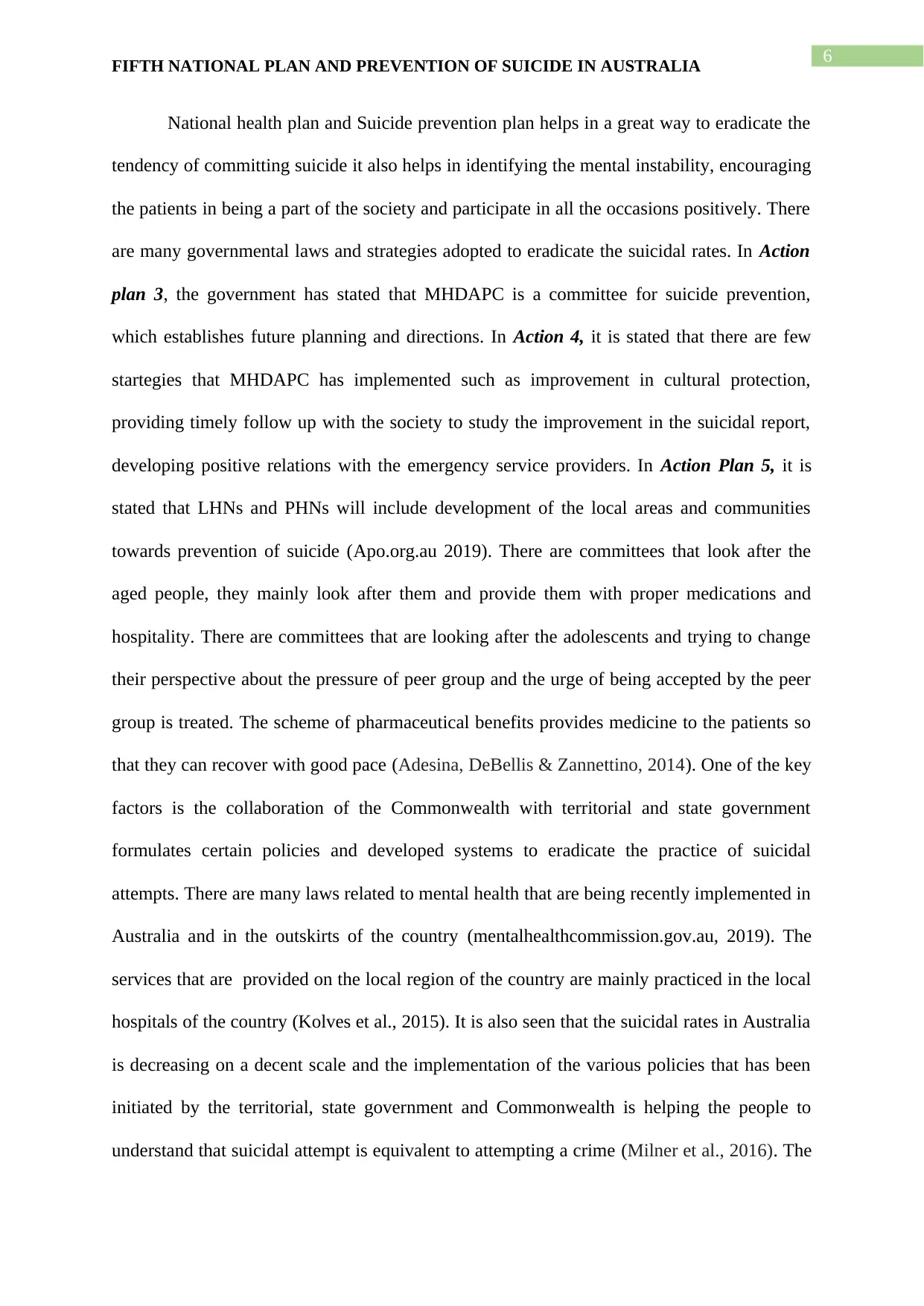
6FIFTH NATIONAL PLAN AND PREVENTION OF SUICIDE IN AUSTRALIA
National health plan and Suicide prevention plan helps in a great way to eradicate the
tendency of committing suicide it also helps in identifying the mental instability, encouraging
the patients in being a part of the society and participate in all the occasions positively. There
are many governmental laws and strategies adopted to eradicate the suicidal rates. In Action
plan 3, the government has stated that MHDAPC is a committee for suicide prevention,
which establishes future planning and directions. In Action 4, it is stated that there are few
startegies that MHDAPC has implemented such as improvement in cultural protection,
providing timely follow up with the society to study the improvement in the suicidal report,
developing positive relations with the emergency service providers. In Action Plan 5, it is
stated that LHNs and PHNs will include development of the local areas and communities
towards prevention of suicide (Apo.org.au 2019). There are committees that look after the
aged people, they mainly look after them and provide them with proper medications and
hospitality. There are committees that are looking after the adolescents and trying to change
their perspective about the pressure of peer group and the urge of being accepted by the peer
group is treated. The scheme of pharmaceutical benefits provides medicine to the patients so
that they can recover with good pace (Adesina, DeBellis & Zannettino, 2014). One of the key
factors is the collaboration of the Commonwealth with territorial and state government
formulates certain policies and developed systems to eradicate the practice of suicidal
attempts. There are many laws related to mental health that are being recently implemented in
Australia and in the outskirts of the country (mentalhealthcommission.gov.au, 2019). The
services that are provided on the local region of the country are mainly practiced in the local
hospitals of the country (Kolves et al., 2015). It is also seen that the suicidal rates in Australia
is decreasing on a decent scale and the implementation of the various policies that has been
initiated by the territorial, state government and Commonwealth is helping the people to
understand that suicidal attempt is equivalent to attempting a crime (Milner et al., 2016). The
National health plan and Suicide prevention plan helps in a great way to eradicate the
tendency of committing suicide it also helps in identifying the mental instability, encouraging
the patients in being a part of the society and participate in all the occasions positively. There
are many governmental laws and strategies adopted to eradicate the suicidal rates. In Action
plan 3, the government has stated that MHDAPC is a committee for suicide prevention,
which establishes future planning and directions. In Action 4, it is stated that there are few
startegies that MHDAPC has implemented such as improvement in cultural protection,
providing timely follow up with the society to study the improvement in the suicidal report,
developing positive relations with the emergency service providers. In Action Plan 5, it is
stated that LHNs and PHNs will include development of the local areas and communities
towards prevention of suicide (Apo.org.au 2019). There are committees that look after the
aged people, they mainly look after them and provide them with proper medications and
hospitality. There are committees that are looking after the adolescents and trying to change
their perspective about the pressure of peer group and the urge of being accepted by the peer
group is treated. The scheme of pharmaceutical benefits provides medicine to the patients so
that they can recover with good pace (Adesina, DeBellis & Zannettino, 2014). One of the key
factors is the collaboration of the Commonwealth with territorial and state government
formulates certain policies and developed systems to eradicate the practice of suicidal
attempts. There are many laws related to mental health that are being recently implemented in
Australia and in the outskirts of the country (mentalhealthcommission.gov.au, 2019). The
services that are provided on the local region of the country are mainly practiced in the local
hospitals of the country (Kolves et al., 2015). It is also seen that the suicidal rates in Australia
is decreasing on a decent scale and the implementation of the various policies that has been
initiated by the territorial, state government and Commonwealth is helping the people to
understand that suicidal attempt is equivalent to attempting a crime (Milner et al., 2016). The
Paraphrase This Document
Need a fresh take? Get an instant paraphrase of this document with our AI Paraphraser
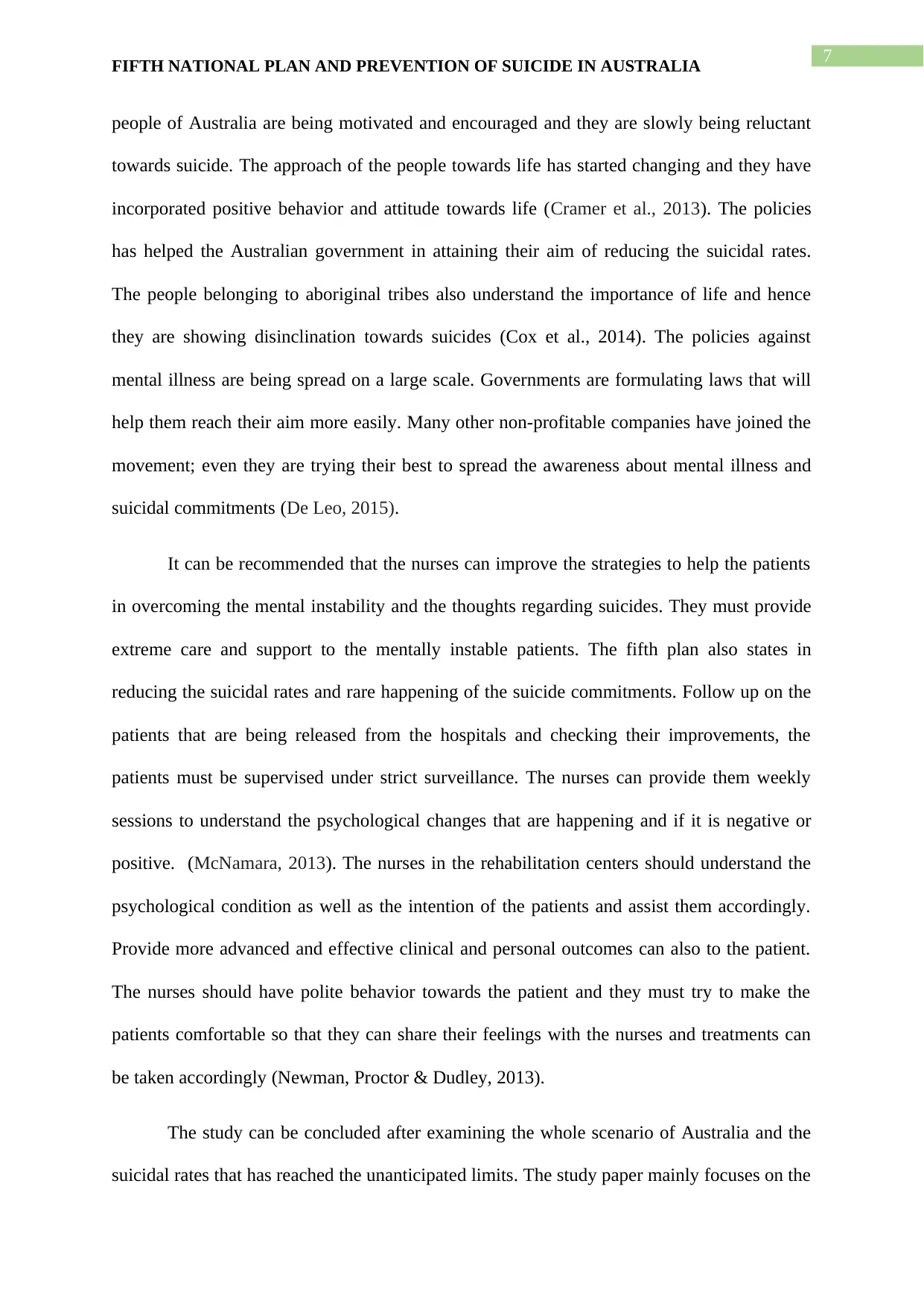
7FIFTH NATIONAL PLAN AND PREVENTION OF SUICIDE IN AUSTRALIA
people of Australia are being motivated and encouraged and they are slowly being reluctant
towards suicide. The approach of the people towards life has started changing and they have
incorporated positive behavior and attitude towards life (Cramer et al., 2013). The policies
has helped the Australian government in attaining their aim of reducing the suicidal rates.
The people belonging to aboriginal tribes also understand the importance of life and hence
they are showing disinclination towards suicides (Cox et al., 2014). The policies against
mental illness are being spread on a large scale. Governments are formulating laws that will
help them reach their aim more easily. Many other non-profitable companies have joined the
movement; even they are trying their best to spread the awareness about mental illness and
suicidal commitments (De Leo, 2015).
It can be recommended that the nurses can improve the strategies to help the patients
in overcoming the mental instability and the thoughts regarding suicides. They must provide
extreme care and support to the mentally instable patients. The fifth plan also states in
reducing the suicidal rates and rare happening of the suicide commitments. Follow up on the
patients that are being released from the hospitals and checking their improvements, the
patients must be supervised under strict surveillance. The nurses can provide them weekly
sessions to understand the psychological changes that are happening and if it is negative or
positive. (McNamara, 2013). The nurses in the rehabilitation centers should understand the
psychological condition as well as the intention of the patients and assist them accordingly.
Provide more advanced and effective clinical and personal outcomes can also to the patient.
The nurses should have polite behavior towards the patient and they must try to make the
patients comfortable so that they can share their feelings with the nurses and treatments can
be taken accordingly (Newman, Proctor & Dudley, 2013).
The study can be concluded after examining the whole scenario of Australia and the
suicidal rates that has reached the unanticipated limits. The study paper mainly focuses on the
people of Australia are being motivated and encouraged and they are slowly being reluctant
towards suicide. The approach of the people towards life has started changing and they have
incorporated positive behavior and attitude towards life (Cramer et al., 2013). The policies
has helped the Australian government in attaining their aim of reducing the suicidal rates.
The people belonging to aboriginal tribes also understand the importance of life and hence
they are showing disinclination towards suicides (Cox et al., 2014). The policies against
mental illness are being spread on a large scale. Governments are formulating laws that will
help them reach their aim more easily. Many other non-profitable companies have joined the
movement; even they are trying their best to spread the awareness about mental illness and
suicidal commitments (De Leo, 2015).
It can be recommended that the nurses can improve the strategies to help the patients
in overcoming the mental instability and the thoughts regarding suicides. They must provide
extreme care and support to the mentally instable patients. The fifth plan also states in
reducing the suicidal rates and rare happening of the suicide commitments. Follow up on the
patients that are being released from the hospitals and checking their improvements, the
patients must be supervised under strict surveillance. The nurses can provide them weekly
sessions to understand the psychological changes that are happening and if it is negative or
positive. (McNamara, 2013). The nurses in the rehabilitation centers should understand the
psychological condition as well as the intention of the patients and assist them accordingly.
Provide more advanced and effective clinical and personal outcomes can also to the patient.
The nurses should have polite behavior towards the patient and they must try to make the
patients comfortable so that they can share their feelings with the nurses and treatments can
be taken accordingly (Newman, Proctor & Dudley, 2013).
The study can be concluded after examining the whole scenario of Australia and the
suicidal rates that has reached the unanticipated limits. The study paper mainly focuses on the

8FIFTH NATIONAL PLAN AND PREVENTION OF SUICIDE IN AUSTRALIA
suicidal rates that has been ever increasing in Australia and the various age groups that are
the victims of mental illness and committed suicide. The various governmental policies and
laws will help the country overcome the high rates of suicides. The reason that lead to mental
illness and tendency of suicide has also been stated and there are many recommendations that
are given in the content of the study to ensure that the suicidal rates are decreasing on a faster
pace.
suicidal rates that has been ever increasing in Australia and the various age groups that are
the victims of mental illness and committed suicide. The various governmental policies and
laws will help the country overcome the high rates of suicides. The reason that lead to mental
illness and tendency of suicide has also been stated and there are many recommendations that
are given in the content of the study to ensure that the suicidal rates are decreasing on a faster
pace.
⊘ This is a preview!⊘
Do you want full access?
Subscribe today to unlock all pages.

Trusted by 1+ million students worldwide
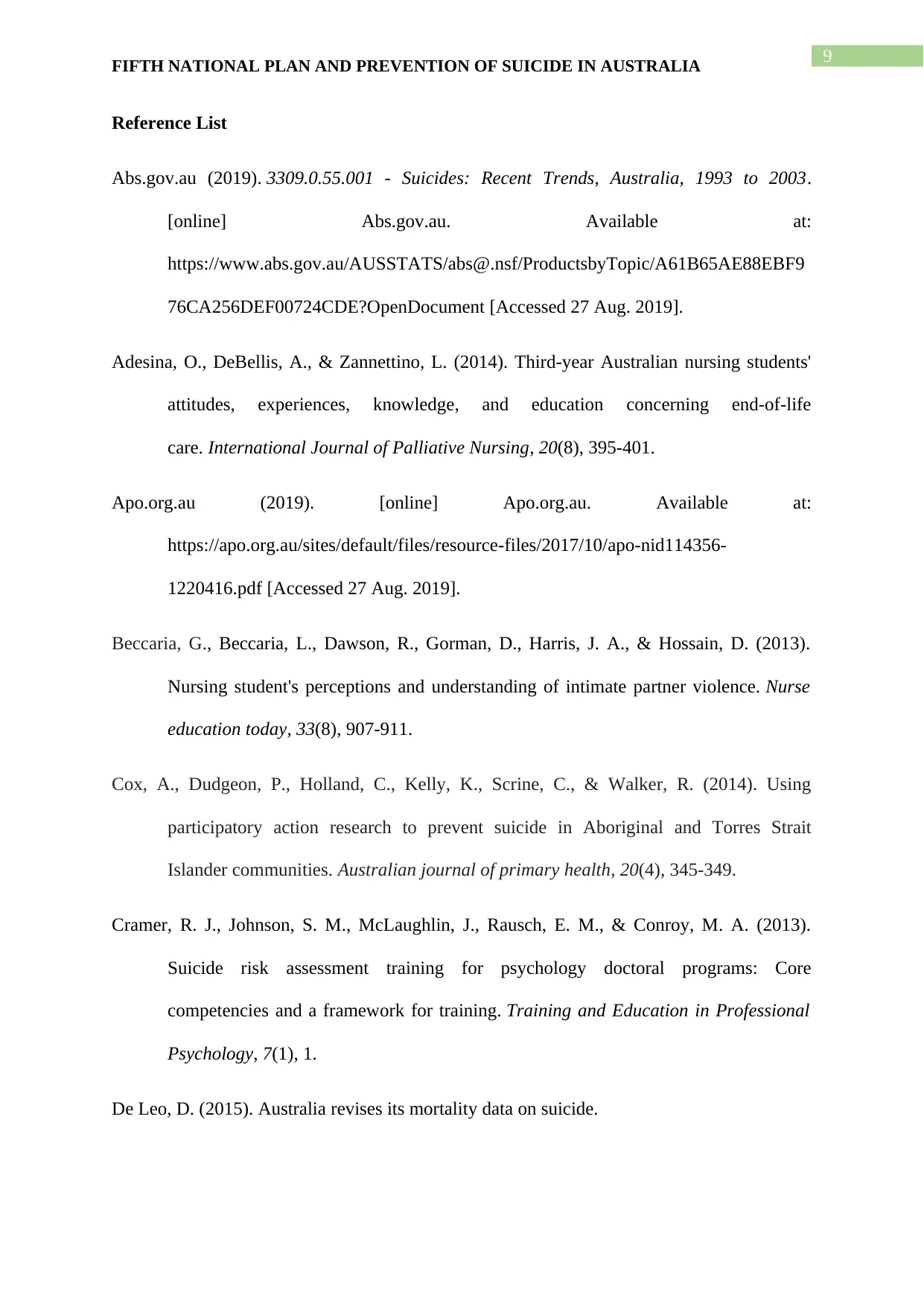
9FIFTH NATIONAL PLAN AND PREVENTION OF SUICIDE IN AUSTRALIA
Reference List
Abs.gov.au (2019). 3309.0.55.001 - Suicides: Recent Trends, Australia, 1993 to 2003.
[online] Abs.gov.au. Available at:
https://www.abs.gov.au/AUSSTATS/abs@.nsf/ProductsbyTopic/A61B65AE88EBF9
76CA256DEF00724CDE?OpenDocument [Accessed 27 Aug. 2019].
Adesina, O., DeBellis, A., & Zannettino, L. (2014). Third-year Australian nursing students'
attitudes, experiences, knowledge, and education concerning end-of-life
care. International Journal of Palliative Nursing, 20(8), 395-401.
Apo.org.au (2019). [online] Apo.org.au. Available at:
https://apo.org.au/sites/default/files/resource-files/2017/10/apo-nid114356-
1220416.pdf [Accessed 27 Aug. 2019].
Beccaria, G., Beccaria, L., Dawson, R., Gorman, D., Harris, J. A., & Hossain, D. (2013).
Nursing student's perceptions and understanding of intimate partner violence. Nurse
education today, 33(8), 907-911.
Cox, A., Dudgeon, P., Holland, C., Kelly, K., Scrine, C., & Walker, R. (2014). Using
participatory action research to prevent suicide in Aboriginal and Torres Strait
Islander communities. Australian journal of primary health, 20(4), 345-349.
Cramer, R. J., Johnson, S. M., McLaughlin, J., Rausch, E. M., & Conroy, M. A. (2013).
Suicide risk assessment training for psychology doctoral programs: Core
competencies and a framework for training. Training and Education in Professional
Psychology, 7(1), 1.
De Leo, D. (2015). Australia revises its mortality data on suicide.
Reference List
Abs.gov.au (2019). 3309.0.55.001 - Suicides: Recent Trends, Australia, 1993 to 2003.
[online] Abs.gov.au. Available at:
https://www.abs.gov.au/AUSSTATS/abs@.nsf/ProductsbyTopic/A61B65AE88EBF9
76CA256DEF00724CDE?OpenDocument [Accessed 27 Aug. 2019].
Adesina, O., DeBellis, A., & Zannettino, L. (2014). Third-year Australian nursing students'
attitudes, experiences, knowledge, and education concerning end-of-life
care. International Journal of Palliative Nursing, 20(8), 395-401.
Apo.org.au (2019). [online] Apo.org.au. Available at:
https://apo.org.au/sites/default/files/resource-files/2017/10/apo-nid114356-
1220416.pdf [Accessed 27 Aug. 2019].
Beccaria, G., Beccaria, L., Dawson, R., Gorman, D., Harris, J. A., & Hossain, D. (2013).
Nursing student's perceptions and understanding of intimate partner violence. Nurse
education today, 33(8), 907-911.
Cox, A., Dudgeon, P., Holland, C., Kelly, K., Scrine, C., & Walker, R. (2014). Using
participatory action research to prevent suicide in Aboriginal and Torres Strait
Islander communities. Australian journal of primary health, 20(4), 345-349.
Cramer, R. J., Johnson, S. M., McLaughlin, J., Rausch, E. M., & Conroy, M. A. (2013).
Suicide risk assessment training for psychology doctoral programs: Core
competencies and a framework for training. Training and Education in Professional
Psychology, 7(1), 1.
De Leo, D. (2015). Australia revises its mortality data on suicide.
Paraphrase This Document
Need a fresh take? Get an instant paraphrase of this document with our AI Paraphraser
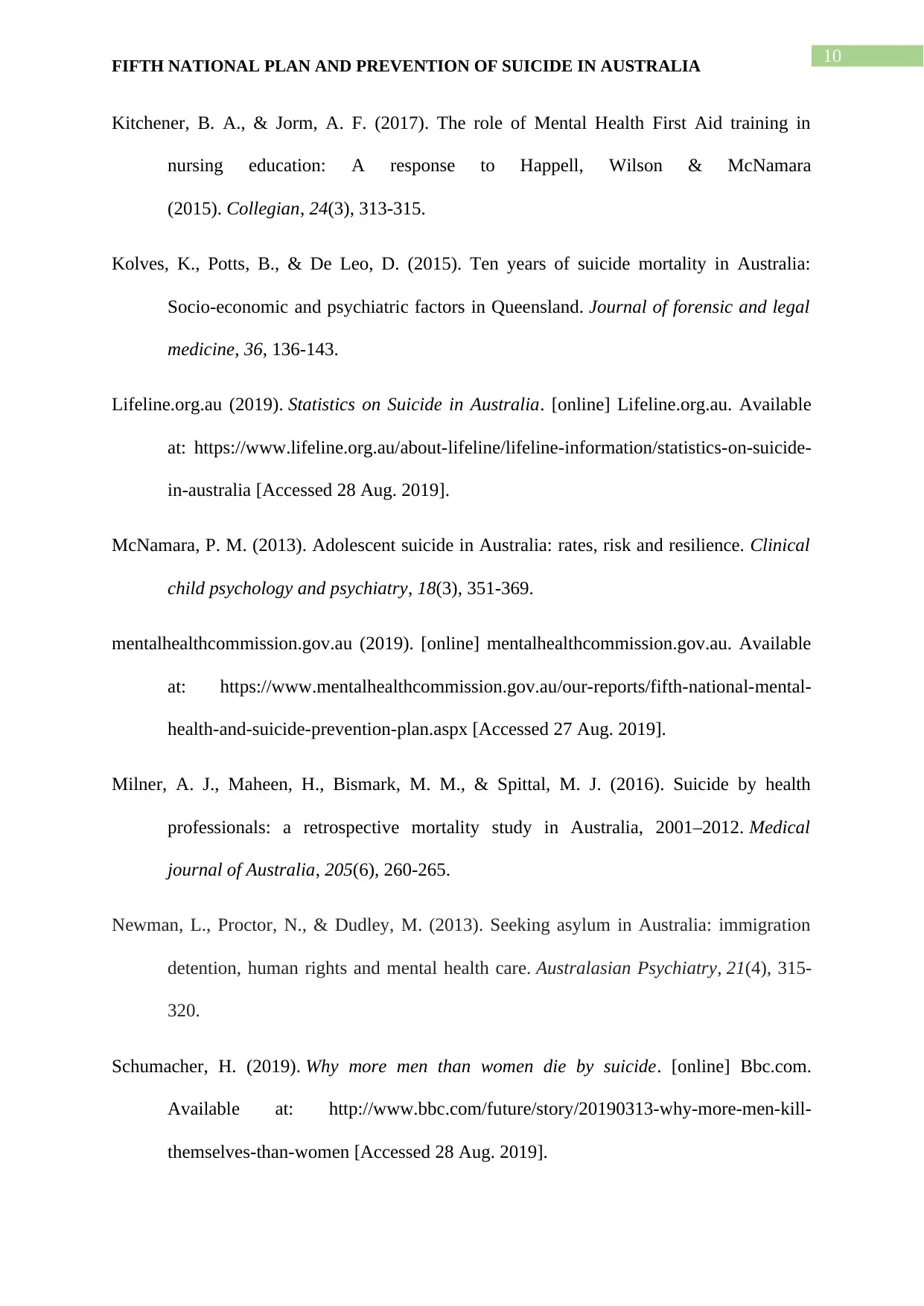
10FIFTH NATIONAL PLAN AND PREVENTION OF SUICIDE IN AUSTRALIA
Kitchener, B. A., & Jorm, A. F. (2017). The role of Mental Health First Aid training in
nursing education: A response to Happell, Wilson & McNamara
(2015). Collegian, 24(3), 313-315.
Kolves, K., Potts, B., & De Leo, D. (2015). Ten years of suicide mortality in Australia:
Socio-economic and psychiatric factors in Queensland. Journal of forensic and legal
medicine, 36, 136-143.
Lifeline.org.au (2019). Statistics on Suicide in Australia. [online] Lifeline.org.au. Available
at: https://www.lifeline.org.au/about-lifeline/lifeline-information/statistics-on-suicide-
in-australia [Accessed 28 Aug. 2019].
McNamara, P. M. (2013). Adolescent suicide in Australia: rates, risk and resilience. Clinical
child psychology and psychiatry, 18(3), 351-369.
mentalhealthcommission.gov.au (2019). [online] mentalhealthcommission.gov.au. Available
at: https://www.mentalhealthcommission.gov.au/our-reports/fifth-national-mental-
health-and-suicide-prevention-plan.aspx [Accessed 27 Aug. 2019].
Milner, A. J., Maheen, H., Bismark, M. M., & Spittal, M. J. (2016). Suicide by health
professionals: a retrospective mortality study in Australia, 2001–2012. Medical
journal of Australia, 205(6), 260-265.
Newman, L., Proctor, N., & Dudley, M. (2013). Seeking asylum in Australia: immigration
detention, human rights and mental health care. Australasian Psychiatry, 21(4), 315-
320.
Schumacher, H. (2019). Why more men than women die by suicide. [online] Bbc.com.
Available at: http://www.bbc.com/future/story/20190313-why-more-men-kill-
themselves-than-women [Accessed 28 Aug. 2019].
Kitchener, B. A., & Jorm, A. F. (2017). The role of Mental Health First Aid training in
nursing education: A response to Happell, Wilson & McNamara
(2015). Collegian, 24(3), 313-315.
Kolves, K., Potts, B., & De Leo, D. (2015). Ten years of suicide mortality in Australia:
Socio-economic and psychiatric factors in Queensland. Journal of forensic and legal
medicine, 36, 136-143.
Lifeline.org.au (2019). Statistics on Suicide in Australia. [online] Lifeline.org.au. Available
at: https://www.lifeline.org.au/about-lifeline/lifeline-information/statistics-on-suicide-
in-australia [Accessed 28 Aug. 2019].
McNamara, P. M. (2013). Adolescent suicide in Australia: rates, risk and resilience. Clinical
child psychology and psychiatry, 18(3), 351-369.
mentalhealthcommission.gov.au (2019). [online] mentalhealthcommission.gov.au. Available
at: https://www.mentalhealthcommission.gov.au/our-reports/fifth-national-mental-
health-and-suicide-prevention-plan.aspx [Accessed 27 Aug. 2019].
Milner, A. J., Maheen, H., Bismark, M. M., & Spittal, M. J. (2016). Suicide by health
professionals: a retrospective mortality study in Australia, 2001–2012. Medical
journal of Australia, 205(6), 260-265.
Newman, L., Proctor, N., & Dudley, M. (2013). Seeking asylum in Australia: immigration
detention, human rights and mental health care. Australasian Psychiatry, 21(4), 315-
320.
Schumacher, H. (2019). Why more men than women die by suicide. [online] Bbc.com.
Available at: http://www.bbc.com/future/story/20190313-why-more-men-kill-
themselves-than-women [Accessed 28 Aug. 2019].
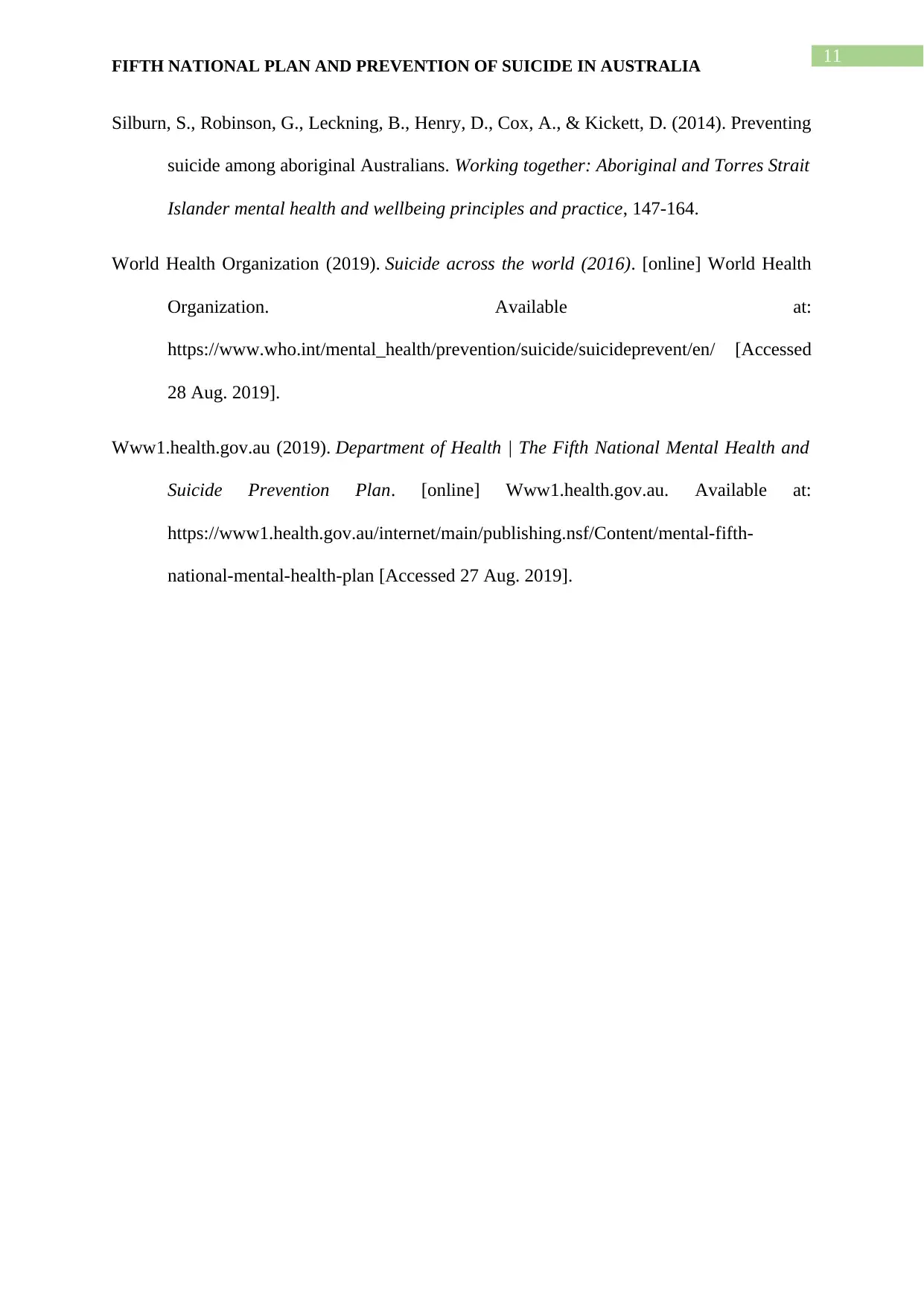
11FIFTH NATIONAL PLAN AND PREVENTION OF SUICIDE IN AUSTRALIA
Silburn, S., Robinson, G., Leckning, B., Henry, D., Cox, A., & Kickett, D. (2014). Preventing
suicide among aboriginal Australians. Working together: Aboriginal and Torres Strait
Islander mental health and wellbeing principles and practice, 147-164.
World Health Organization (2019). Suicide across the world (2016). [online] World Health
Organization. Available at:
https://www.who.int/mental_health/prevention/suicide/suicideprevent/en/ [Accessed
28 Aug. 2019].
Www1.health.gov.au (2019). Department of Health | The Fifth National Mental Health and
Suicide Prevention Plan. [online] Www1.health.gov.au. Available at:
https://www1.health.gov.au/internet/main/publishing.nsf/Content/mental-fifth-
national-mental-health-plan [Accessed 27 Aug. 2019].
Silburn, S., Robinson, G., Leckning, B., Henry, D., Cox, A., & Kickett, D. (2014). Preventing
suicide among aboriginal Australians. Working together: Aboriginal and Torres Strait
Islander mental health and wellbeing principles and practice, 147-164.
World Health Organization (2019). Suicide across the world (2016). [online] World Health
Organization. Available at:
https://www.who.int/mental_health/prevention/suicide/suicideprevent/en/ [Accessed
28 Aug. 2019].
Www1.health.gov.au (2019). Department of Health | The Fifth National Mental Health and
Suicide Prevention Plan. [online] Www1.health.gov.au. Available at:
https://www1.health.gov.au/internet/main/publishing.nsf/Content/mental-fifth-
national-mental-health-plan [Accessed 27 Aug. 2019].
⊘ This is a preview!⊘
Do you want full access?
Subscribe today to unlock all pages.

Trusted by 1+ million students worldwide
1 out of 12
Related Documents
Your All-in-One AI-Powered Toolkit for Academic Success.
+13062052269
info@desklib.com
Available 24*7 on WhatsApp / Email
![[object Object]](/_next/static/media/star-bottom.7253800d.svg)
Unlock your academic potential
Copyright © 2020–2025 A2Z Services. All Rights Reserved. Developed and managed by ZUCOL.





